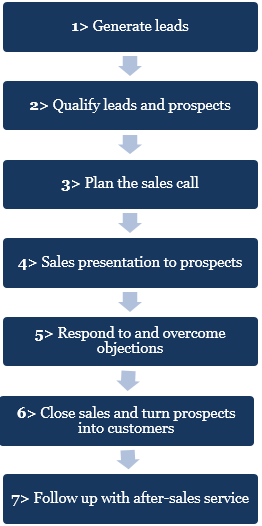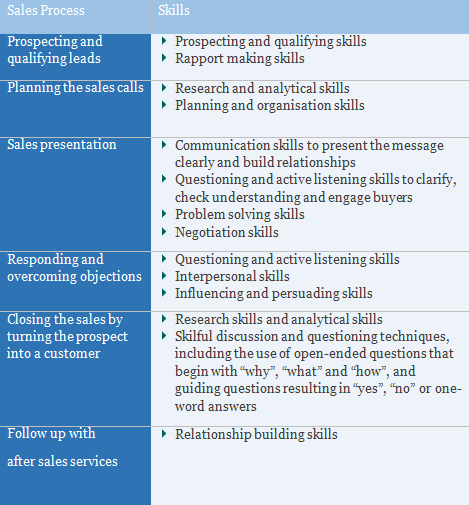How do I generate leads and sales?
Putting a systematic approach in place to manage the sales process creates a higher chance of turning sales leads into customers. A sales process is a systematic and on-going process that a salesperson follows through to result in the closing of a sale. The sales process goes through the following stages:

Act on It Manage your sales process The process of selling could take quite long depending on the complexity of the solution, number of stakeholders, cost, sales volume and whether testing is needed. A sales process that helps to monitor key milestones and actions along the way helps to maintain morale and teamwork, and avoid losing customers through poor follow up. Use the editable template provided: Manage Your Sales Process
Tip Search for information Search on the Internet on how to manage an effective sales funnel for your business. Once you are familiar with the process, you can revise and standardise it using the best practices in your industry.
Step 1
Use the promotion components described in the previous section to generate leads. The contacts that you receive through these efforts are called leads. Lead generation is a win-win for both the buyers and sellers. When buyers request information from sellers that offer the products or services, the sellers are given the opportunity to pitch their products or services to buyers who have interest in buying the products.
Ideas for Lead Generation
- Write articles about your products (article marketing) and post it to article syndication sites on the Internet. Others who like your article may republish it on their websites or blogs. This will generate more leads to your articles. Ensure you include a call to action in your article to get them to visit your website and provide you their email addresses. Entice them to do so by offering them free trial consulting services, or free sneak previews to your products through DVDs, CDs, MP3s.
- Join LinkedIn, Facebook, and Twitter to get more traffic and create a channel for people to interact with you. For example, at LinkedIn – the network for business professionals with over 70 million members – you can create a business profile, provide news, join interest groups and participate in discussions to get potential leads.
- You can join the B2B Lead Generation Roundtable group https://www.b2bleadblog.com/b2b-lead-gen-roundtable/ to receive information on lead generation. Establish yourself as a credible source of information to turn leads into prospects who will keep returning to you for more information. You can tap on selling opportunities once your leads are comfortable to do business with you.
- Motivate visitors to sign up for free information by providing you with their names and email addresses. Win these visitors over by providing information without an underlying sales pitch. Encourage these potential sales leads to register as a member to join your company’s interest groups.
- Promote your business on Google by displaying your advertisement. Pay Google only when people click on the advertisement to visit your website. Read Google AdWords success stories for reference.
- Use social media - create a group within the group, create an advertisement, post questions and start discussions. Interest them in the technologies and challenges in your industry, and how companies like yourself are solving them.
Tip Rental Lists You can develop your own in-house database of leads or as an alternative, buy or rent from companies specialising in this business. If you decide to purchase a mailing list, ensure that the broker is reliable. Discuss with them on how to define the search in order to get a quality list with a high percentage of prospects who are likely to be converted into customers.
Tip Article Syndication Sites You can submit your free articles to the following free article directories: http://www.ezinearticles.com/ http://www.articlesbase.com/submit-articles.php You can also refer to the following websites for a comprehensive list of free article syndication sites: http://www.socialseo.com/the-best-free-article-syndication-sites.html
Step 2
Sales leads are worthless if there is no follow up action to turn them into prospects. Good prospects are people who are likely to be interested in the product and are willing to make the purchase. Once you have captured sales leads, gather their profiles and build your mailing list. Start planning on how to approach these sales leads based on the products that interest them, the geographical area you are able to serve and the number of sales leads that you can effectively manage. A few scenarios are given to illustrate strategies on creating interest in sales leads.

Step 3
You need to understand your prospects before making your sales calls. Look at your entire list of leads and prioritise the best leads, based on obvious or urgent need to use your product, sufficient financial ability and the role they play in the buying process. Invest time in researching on these prospects, thinking through your sales approach and planning your presentation. Gather as much background information as possible about your prospects. What information should you find out?
- What is your prospect’s business?
- What are their needs?
- Who makes the buying decisions?
- What products are relevant?
- What is their budget?
- When is the best time to meet?
- Where is the best venue to meet?
- Who are your competitors?
- What are their strengths and weaknesses compared to yours?
Step 4
You begin to establish rapport with the prospect and manage to make an appointment to present your product to the decision makers. Uncover more about the needs of your prospects, follow through on their requests and win their final approval to buy your product. How do you make an impactful presentation?
- Be passionate and enthusiastic about your product
- Have in-depth knowledge of your product
- Focus on the benefits of the product that solve the customers’ problems and meet their objectives
- Listen more and talk less to understand the buyer’s intentions, considerations and reasons underlying their purchase decision
- Communicate using vocabulary and language that the buyers can understand and avoid industry terminology
- Customise your sales presentation; using a generic presentation shows a lack of sincerity
If you are confident, you may prepare a sale proposal with adequate information to speed up the sales process if the sales presentation goes well. Don’t get discouraged if you can’t close the sales on the first sales call, but do request for a follow-up appointment or a time to call them again.
Tip Building sales relationships You need to spend time on every sales effort. Take enough time to understand the buyer’s needs, problems, challenges and concerns. Give the prospect full attention to uncover buying opportunities and how you can help the prospect to solve their problems, concerns, challenges and needs.
Step 5
Learn how to respond to and overcome objections from prospects. With most sales attempts, the prospect may say things like “your price is too high”, “I am comfortable with my current suppliers”, “I don’t know much about your company” or “send me your product literature and I will get back to you”.
Some objections are genuine because the buyers want their concerns to be addressed before making purchases, while some are merely brush offs and they are unlikely to become customers. Your job is to learn to assess which ones you should focus your efforts on - listen to them and provide more information to reassure them.
How do you respond to objections?
- Present yourself professionally
- Discuss their concerns, challenges and issues
- Listen carefully and acknowledge their concerns
- Provide information to address their concerns
- Help them to see their need
- Offer solutions to their challenges
- Clarify their doubts
- Show credentials and testimonials to support your product propositions
- Create a sense of urgency by presenting a reason to buy now, eg. a promotion period
- Don’t be pushy
- If the buyer is not ready, get the next appointment and follow up
Step 6
Closing the sale and turning your prospect into your customer can be simple or complicated depending on the prospect’s requirement. In a B2B situation, you may have to prepare a formal proposal on the purchase of the product for your customer and follow up with an official contract. In a B2C situation, you may only need to prepare a simple one-page document to close the deal, if at all. To close sales, first give a summary of the benefits of your product, and then ask for the order from your customer. If your customer does not agree to the deal, offer a concession then ask for the order again.

Step 7
At this point, you will hand-over the first order to support staff that will fulfil the order requirements. However, you will need to provide after-sales service and continue to serve, monitor, deliver promises and maintain the account to ensure that your customer is satisfied and continues his business with you.Developing and using effective selling skills can improve sales performance significantly. In the sales process, you have to observe your sales attitude to make sure the prospects are comfortable with sharing their challenges, problems and concerns.
With the appropriate attitude and skills, you can uncover your customers’ needs and provide the right solutions. You need to be patient yet persistent enough to follow through each step of the sales process in order to close sales. The consultative sales approach in personal selling is effective in winning and keeping customers. The consultative process emphasises on listening to the customer, gathering inputs, providing information, problem solving and negotiation, rather than manipulation. The sales team develops a customer-centric strategy and takes on various roles including advisors, problem analysers and solution providers to customers. They are perceived as partners with integrity who are able to present solutions that are relevant to the customers’ needs and are keen to build long-term relationships rather than reap short-term gains.